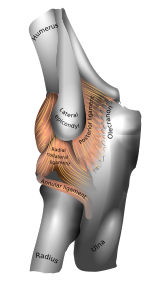| Tennis elbow | |
|---|---|
| Other names | Lateral epicondylitis, lateral elbow tendinopathy[1] |
 | |
| Left elbow-joint. (Lateral epicondyle visible at center.) | |
| Specialty | Orthopedics, sports medicine |
| Symptoms | Painful and tender outer part of the elbow[1] |
| Usual onset | Gradual[2] |
| Duration | Less than 1 to 2 years[3] |
| Causes | Middle age (ages 35-60). |
| Diagnostic method | Symptoms and physical examination |
| Differential diagnosis | Osteoarthritis |
| Treatment | Nothing is proved to alter the natural course of the disease. Exercises, braces, ice or heat, and medications may be palliative. |
Tennis elbow, also known as lateral epicondylitis or enthesopathy of the extensor carpi radialis origin, is an enthesopathy (attachment point disease) of the origin of the extensor carpi radialis brevis on the lateral epicondyle.[1][4] Those with tennis elbow often report pain and tenderness over the bony prominence of the lateral epicondyle, which serves as the common origin of the forearm and hand’s long extensor tendons. Symptoms range from mild tenderness to severe, persistent pain.[1][5][6] The pain may also extend into the back of the forearm.[2] Onset of symptoms is generally gradual, although they can seem sudden and be misinterpreted as an injury.[7][2][8]
Tennis elbow is generally considered idiopathic, with the exact cause and pathogenesis still unknown, though it is thought to involve tendinosis, a degenerative process of the local tendon.[9][10]
It is often stated that the condition is caused by excessive use of the muscles of the back of the forearm, but this is not supported by experimental evidence and is a common misinterpretation or unhelpful thought about symptoms.[11][2][12] It may be associated with work or sports, classically racquet sports (including paddle sports), but most people with the condition are not exposed to these activities.[1][2][13] The diagnosis is based on the symptoms and examination. Medical imaging is not particularly useful.[2][10] Signs consistent with the diagnosis include pain when a subject tries to bend back the wrist against resistance.[1]
The natural history of untreated enthesopathy is resolution over a period of 1–2 years.[14] Palliative (symptoms alleviating) treatment may include pain medications such as NSAIDS or acetaminophen (paracetamol), a wrist brace, or a strap over the upper forearm.[1][2] The role of corticosteroid injections as a form of treatment is still debated.[15] Recent evidence suggests that corticosteroid injections may delay symptom resolution.[16]
- ^ a b c d e f g Hubbard MJ, Hildebrand BA, Battafarano MM, Battafarano DF (June 2018). "Common Soft Tissue Musculoskeletal Pain Disorders". Primary Care. 45 (2): 289–303. doi:10.1016/j.pop.2018.02.006. PMID 29759125. S2CID 46886582.
- ^ a b c d e f g "Tennis Elbow (Lateral Epicondylitis)". OrthoInfo. July 2015. Retrieved 21 June 2018.
- ^ Vaquero-Picado A, Barco R, Antuña SA (November 2016). "Lateral epicondylitis of the elbow". EFORT Open Reviews. 1 (11): 391–397. doi:10.1302/2058-5241.1.000049. PMC 5367546. PMID 28461918.
- ^ Faro, Frances; Wolf, Jennifer Moriatis (October 2007). "Lateral Epicondylitis: Review and Current Concepts". The Journal of Hand Surgery. 32 (8): 1271–1279. doi:10.1016/j.jhsa.2007.07.019. ISSN 0363-5023. PMID 17923315.
- ^ Behazin M, Kachooei AR (March 2021). "Arthroscopic Recession Technique in the Surgery of Tennis Elbow by Sharp Cutting the Extensor Carpi Radialis Brevis (ECRB) Tendon Origin". The Archives of Bone and Joint Surgery. 9 (2): 174–179. doi:10.22038/abjs.2020.48173.2383. PMC 8121031. PMID 34026934.
- ^ Cutts, S.; Gangoo, Shafat; Modi, Nitin; Pasapula, Chandra (2020). "Tennis elbow: A clinical review article". Journal of Orthopaedics. 17: 203–207. doi:10.1016/j.jor.2019.08.005. ISSN 0972-978X. PMC 6926298. PMID 31889742.
- ^ Lemmers, M.; Versluijs, Y.; Kortlever, J.; Gonzalez, A.; Ring, D. (2020). "Misperception of Disease Onset in People with Gradual-Onset Disease of the Upper Extremity". The Journal of Bone and Joint Surgery. 102 (24): 2174–2180. doi:10.2106/JBJS.20.00420. hdl:1887/3638637. PMID 33027085. S2CID 222211926.
- ^ Solheim E, Hegna J, Øyen J (June 2011). "Extensor tendon release in tennis elbow: results and prognostic factors in 80 elbows". Knee Surgery, Sports Traumatology, Arthroscopy. 19 (6): 1023–1027. doi:10.1007/s00167-011-1477-1. PMC 3096769. PMID 21409461.
- ^ Gorski JM (August 2019). "Evaluation of Sleep Position for Possible Nightly Aggravation and Delay of Healing in Tennis Elbow". Journal of the American Academy of Orthopaedic Surgeons. Global Research & Reviews. 3 (8): e082. doi:10.5435/JAAOSGlobal-D-19-00082. PMC 6754212. PMID 31592507.
- ^ a b Ma, Kun-Long; Wang, Hai-Qiang (2020). "Management of Lateral Epicondylitis: A Narrative Literature Review". Pain Research & Management. 2020: 6965381. doi:10.1155/2020/6965381. PMC 7222600. PMID 32454922.
- ^ Teunis, T.; Salman, A. A. I.; Koeing, K.; Ring, D.; Amirreza, A. (2022). "Unhelpful Thoughts and Distress Regarding Symptoms Limit Accommodation of Musculoskeletal Pain". Clin Orthop Relat Res. 480 (2): 276–283. doi:10.1097/corr.0000000000002006. PMC 8747479. PMID 34652286. S2CID 238990392.
- ^ Bunata RE, Brown DS, Capelo R (September 2007). "Anatomic factors related to the cause of tennis elbow". The Journal of Bone and Joint Surgery. American Volume. 89 (9): 1955–1963. doi:10.2106/JBJS.F.00727. PMID 17768192.
- ^ "Mouse Elbow - Injury Overview". 17 May 2017.
- ^ Vaquero-Picado A, Barco R, Antuña SA (November 2016). "Lateral epicondylitis of the elbow". EFORT Open Reviews. 1 (11): 391–397. doi:10.1302/2058-5241.1.000049. PMC 5367546. PMID 28461918.
- ^ Saygin D, Tabib T, Bittar HE, Valenzi E, Sembrat J, Chan SY, et al. (2022-09-06). "Transcriptional profiling of lung cell populations in idiopathic pulmonary arterial hypertension". Pulmonary Circulation. 10 (1). Wiley. doi:10.1002/14651858.cd001978.pub2. PMC 7052475. PMID 32166015. S2CID 252151420.
- ^ Hsieh LF, Kuo YC, Lee CC, Liu YF, Liu YC, Huang V (February 2018). "Comparison Between Corticosteroid and Lidocaine Injection in the Treatment of Tennis Elbow: A Randomized, Double-Blinded, Controlled Trial". American Journal of Physical Medicine & Rehabilitation. 97 (2): 83–89. doi:10.1097/PHM.0000000000000814. PMID 28816704. S2CID 24498663.